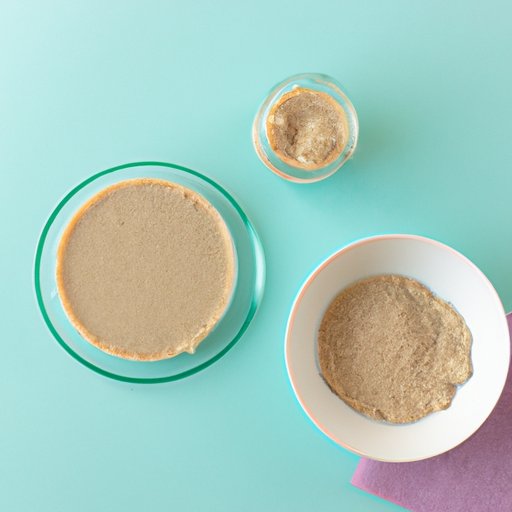Introduction
Yeast infections are a common issue that many people experience. They can be uncomfortable and cause an array of symptoms, but luckily, there are several ways to treat them at home. In this article, we’ll explore how to cure a yeast infection at home fast with simple tips.
Overview of Yeast Infections
Yeast infections are caused by an overgrowth of a fungus known as Candida albicans. This fungus is naturally found in the body, but when it grows too much, it can lead to a yeast infection. It can affect both men and women, but it’s more common in women.
Symptoms of Yeast Infections
The symptoms of a yeast infection can vary from person to person, but they may include itching, burning, redness, swelling, and pain in the affected area. There may also be a white discharge or cottage cheese-like discharge. In some cases, the symptoms can be mild, but in others, they can be quite severe.
How to Cure a Yeast Infection at Home Fast
There are several ways to treat a yeast infection at home. Here are some tips to help you get rid of the infection quickly.
Consume Probiotics
Probiotics are beneficial bacteria that can help restore the balance of bacteria in the body. Consuming probiotics can help reduce the symptoms of a yeast infection and help get rid of it quickly.
Benefits of Probiotics
Probiotics have a wide range of benefits, including improving digestion, boosting immunity, and reducing inflammation. They can also help reduce the symptoms of a yeast infection, such as itching and burning.
Types of Probiotics to Consider
When looking for probiotics, it’s important to look for ones that contain live cultures. Some good sources of probiotics include yogurt, kefir, sauerkraut, and kimchi. You can also take a probiotic supplement to get the benefits.
Practice Proper Hygiene
Good hygiene practices can help reduce the risk of developing a yeast infection. It’s important to keep the affected area clean and dry to prevent the growth of bacteria and fungus.
Bathing and Showering
It’s important to bathe or shower regularly to keep the affected area clean. Be sure to use a mild soap and warm water, and avoid scrubbing the area too hard. After showering, it’s important to pat the area dry to avoid moisture buildup.
Washing Intimate Areas
It’s especially important to wash the intimate areas regularly to reduce the risk of developing a yeast infection. Use a mild soap and warm water, and be sure to rinse thoroughly. Avoid using scented soaps or body washes, as these can irritate the area.
Avoid Douching
Douching can disrupt the natural balance of bacteria in the body, which can increase the risk of developing a yeast infection. It’s best to avoid douching altogether, as it can make the infection worse.
Reasons to Avoid Douching
Douching can irritate the delicate tissues in the vagina, which can make the infection worse. It can also cause an imbalance in the natural bacteria in the body, making it harder for the body to fight off the infection.
Alternatives to Douching
If you want to keep the area clean, it’s best to stick to bathing or showering. You can also use a mild soap and warm water to wash the area. Be sure to rinse thoroughly and pat the area dry after washing.
Wear Breathable Underwear
Wearing breathable underwear can help reduce the risk of developing a yeast infection. The fabric should be lightweight and allow air to circulate to keep the area dry.
What is Breathable Underwear?
Breathable underwear is made from fabrics that allow air to circulate, such as cotton. This type of fabric helps keep the area dry and reduces the risk of developing a yeast infection.
Where to Find Breathable Underwear
You can find breathable underwear in most stores, including department stores and lingerie shops. It’s also available online from a variety of retailers.
Eat Yogurt or Other Fermented Foods
Eating yogurt or other fermented foods can help reduce the symptoms of a yeast infection. These foods contain beneficial bacteria that can help restore the balance of bacteria in the body and fight off the infection.
Benefits of Eating Fermented Foods
Fermented foods are rich in beneficial bacteria, which can help restore the balance of bacteria in the body. They can also help reduce inflammation and improve digestion.
Types of Fermented Foods to Eat
Some good sources of fermented foods include yogurt, kefir, sauerkraut, kimchi, miso, and tempeh. You can also take a probiotic supplement if you don’t like the taste of fermented foods.
Conclusion
Yeast infections can be uncomfortable and cause an array of symptoms, but luckily, there are several ways to treat them at home. Consuming probiotics, practicing good hygiene, avoiding douching, wearing breathable underwear, and eating fermented foods can all help reduce the symptoms of a yeast infection and help get rid of it quickly.
If you’re experiencing symptoms of a yeast infection, it’s best to see your doctor to get an accurate diagnosis. Your doctor can provide you with treatment options, as well as advice on how to prevent future infections.
Resources for Further Information
For further information on treating yeast infections, here are some helpful resources:


